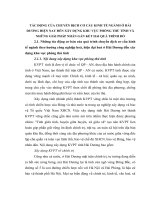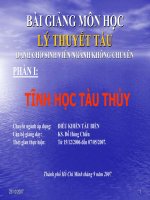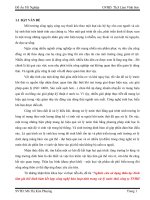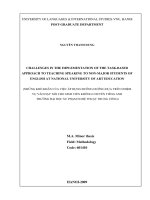Áp dụng đường hướng kết hợp quá trình và dựa vào thể loại trong việc dạy viết luận IELTS, phần 2 cho sinh viên khối không chuyên trình độ 4.5-5.5 tại một trường đại học ở Việt Nam
Bạn đang xem bản rút gọn của tài liệu. Xem và tải ngay bản đầy đủ của tài liệu tại đây (329.83 KB, 15 trang )
VIETNAM NATIONAL UNIVERSITY, HANOI
UNIVERSITY OF LANGUAGES AND INTERNATIONAL STUDIES
FACULTY OF POST-GRADUATE STUDIES
***************************
TRẦN THỊ THƠ
AN ACTION RESEARCH STUDY ON A PROCESS-GENRE
APPROACH TO TEACHING IELTS WRITING TASK 2 TO
NON-ENGLISH MAJOR STUDENTS AT BAND 4.5-5.5 IN A
VIETNAMESE UNIVERSITY SETTING
Nghiên cứu cải tiến sư phạm về việc áp dụng đường hướng kết hợp quá trình và
dựa vào thể loại trong việc dạy viết luận IELTS, phần 2, cho sinh viên khối không
chuyên tại một trường Đại học ở Việt Nam
M.A. MINOR PROGRAMME THESIS
Field: English Teaching Methodology
Code: 60140111
HANOI-2016
VIETNAM NATIONAL UNIVERSITY, HANOI
UNIVERSITY OF LANGUAGES AND INTERNATIONAL STUDIES
FACULTY OF POST-GRADUATE STUDIES
***************************
TRẦN THỊ THƠ
AN ACTION RESEARCH STUDY ON A PROCESS-GENRE
APPROACH TO TEACHING IELTS WRITING TASK 2 TO
NON-ENGLISH MAJOR STUDENTS AT BAND 4.5-5.5 IN A
VIETNAMESE UNIVERSITY SETTING
Nghiên cứu cải tiến sư phạm về việc áp dụng đường hướng kết hợp quá trình và
dựa vào thể loại trong việc dạy viết luận IELTS, phần 2, cho sinh viên khối không
chuyên tại một trường Đại học ở Việt Nam
M.A. MINOR PROGRAMME THESIS
Field: English Teaching Methodology
Code: 60140111
Supervisor:Dr. Hoàng Thị Hạnh
HANOI-2016
Contents
Statement of Ownership .............................................................................................. i
Acknowledgements ................................................... Error! Bookmark not defined.
Abstract ..................................................................... Error! Bookmark not defined.
List of Abbreviations................................................. Error! Bookmark not defined.
List of tables and figures ........................................... Error! Bookmark not defined.
PART A: INTRODUCTION ....................................................................................III
1. Rationale of the Research ..................................................................................III
2. Aims, Scope, Methods, and Significance of the Study .................................... IV
2.1. Aims and Objectives .................................................................................. IV
2.2. Scope of the Study ........................................................................................ V
2.3. Research methods ......................................................................................... V
2.4. Significance of the Study ............................................................................. V
PART B: DEVELOPMENT .................................................................................... VI
CHAPTER 1: LITERATURE REVIEW ................................................................. VI
1.1. IELTS: the International English Language Testing System ........................ VI
1.2. Process-based approaches ............................................................................. VII
1.2.1. Model of process-based approaches ....................................................... VII
1.2.2. Advantages and disadvantages of process-based approaches ................ VII
1.3. Genre-based approaches ................................. Error! Bookmark not defined.
1.3.1. Model of genre-based approaches ............ Error! Bookmark not defined.
1.3.2. Advantages and disadvantages of genre-based approaches ............. Error!
Bookmark not defined.
1.4. The Process Approach vs the Genre Approach ............ Error! Bookmark not
defined.
1.5. Integrating process and genre approaches to teaching writing ............... Error!
Bookmark not defined.
1.6. Process-genre approaches ............................... Error! Bookmark not defined.
I
1.7. Previous studies on the applications of process-genre approach to teaching L2
writing: findings and limitations ............................ Error! Bookmark not defined.
CHAPTER 2: METHODOLOGY ............................ Error! Bookmark not defined.
2.1. The current situation of IELTS in Vietnam .... Error! Bookmark not defined.
2.2. IELTS in National University of Civil Engineering (NUCE) ................ Error!
Bookmark not defined.
2.3. The Context of the Study and the Research Participants..... Error! Bookmark
not defined.
2.3.1. The research participants .......................... Error! Bookmark not defined.
2.3.2. The writing IELTS Preparation course in NUCE .. Error! Bookmark not
defined.
2.4. Action Research .............................................. Error! Bookmark not defined.
2.5. Data collection procedure ............................... Error! Bookmark not defined.
2.6. Data Collection Methods ................................ Error! Bookmark not defined.
2.6.1. Observation .............................................. Error! Bookmark not defined.
2.6.2. Semi-structured interviews ....................... Error! Bookmark not defined.
2.6.3. Collection of students’ writings throughout the program ................ Error!
Bookmark not defined.
2.7. Data Analysis Procedures ............................... Error! Bookmark not defined.
2.7.1. Data from observations and interviews .... Error! Bookmark not defined.
2.7.2. Data from the collection of student’s writings ....... Error! Bookmark not
defined.
CHAPTER 3: ANALYSIS AND DISCUSSION OF FINDINGS Error! Bookmark
not defined.
3.1. Findings and analysis ...................................... Error! Bookmark not defined.
3.1.1. Students’ perceptions of process-genre approach application ......... Error!
Bookmark not defined.
3.1.2. The effectiveness of process-genre approach on students’ writings Error!
Bookmark not defined.
II
3.2. Discussion ....................................................... Error! Bookmark not defined.
CHAPTER 4: CONCLUSIONS ............................... Error! Bookmark not defined.
4.1. Synthesis of the study’s major findings .......... Error! Bookmark not defined.
4.1.1. Research question 1 .................................. Error! Bookmark not defined.
4.1.2. Research question 2 .................................. Error! Bookmark not defined.
4.2. Pedagogical implications ................................ Error! Bookmark not defined.
4.3. Limitations of the study .................................. Error! Bookmark not defined.
4.4. Suggestions for further studies ....................... Error! Bookmark not defined.
REFERENCES ......................................................................................................... IX
APPENDIXES .......................................................... Error! Bookmark not defined.
III
PART A: INTRODUCTION
1. Rationale of the Research
Writing skill is deemed to be difficult for EFL students in the language learning
(Richards, 1990). According to Richard and Renandya (2002), the difficulties
include those in generating and organizing ideas, using an appropriate choice of
vocabulary, sentence and paragraph organization and putting such ideas into an
intelligible text. As for Vietnamese EFL students, besides these difficulties, they
have to face many other obstacles when learning to write compositions in English,
especially to non-English major students who are taking IELTS exams.
In IELTS writing task 2, students are asked to respond to a topic by giving and
justifying an opinion, discussing the topic, summarizing details, outlining problems,
identifying possible solutions and supporting their ideas with reasons, arguments
and relevant examples from their own knowledge or experience (IELTS Test
Booklet, 2014). To non-English major students, it is even quite a challenge to make
a sentence on their own, not to mention a short simple paragraph. As a consequence,
the task of composing complicated essays like in IELTS writing task 2 become
harder, which they rarely perform well.
Although some approaches are applied in teaching writing such as process and
genre-based, besides the merits, there are also some drawbacks in each of these
approaches. The former helps learners to develop more effective ways of conveying
meaning and to better comprehend the content that they want to express (Walsh,
2004). However, it has a very restricted view of writing, in which the practice of
writing is identical regardless of what the topic is and who the writer or the reader is
(Badger & White, 2000). The latter is seen as an extension of the product approach,
in which the writing “varies with the social context in which it is produced” (Badger
& White, 2000, p. 155), also critised because it may not requires students to express
IV
their own ideas or may be too dependent on the teacher finding suitable materials as
models (Caudery, 1998).
With the hope to seek for ways that can enhance students’ writing skills in IELTS
task 2, especially of those who do not major in English, and lessen disadvantages of
process and genre-based approach, the researcher would like to test whether the
integrated approach of these two above which was developed by Badger & White
(2000) could help students improve their writing and whether they find such
approach effective.
2. Aims, Scope, Methods, and Significance of the Study
2.1. Aims and Objectives
This research tries to seek the possibilities to apply process-genre approach in
teaching writing skills to non-English major students in IELTS preparation courses.
While each approach has its own upsides and downsides in teaching application, the
more effective one for writing needs is to incorporate the insights of these
approaches (Badger & White, 2000). Also, this research aims to unpack the factors
that effect students’ writing performance.
The above goals are specified into the following objectives:
To explore the perspectives of the students towards process-genre approach in
learning IELTS writing task 2
To see whether the application of the process-genre approach to teaching
writing IELTS task 2 to non-English major students is effective
To achieve the above-stated aims and objectives, the study was designed to answer
the following research questions:
(1) What do students perceive about process-genre approach in learning writing
IELTS writing task 2?
V
(2) Does the integrated process-genre approach help improve students’
performance in IELTS writing task 2? If yes, to what extent?
2.2. Scope of the Study
The research is confined to the application of the process-genre approach to
teaching writing Task 2 in IELTS exams in a writing course of 15 lessons. A class
of 14 non-English major students was investigated.
2.3. Research methods
As regarded as “the practical judgment in concrete situations”, which support the
practitioner researchers in facing with the challenge and problems of practice and
carrying through innovations in a reflective way (Altrichter, Feldman, Posch, and
Somekh, 2013), the action research was selected to investigate the practicability of
process-genre approach in teaching and learning IELTS writing Task 2. The
research instruments were the pre-test and post-test, writing portfolios and
interviews.
2.4. Significance of the Study
There are some reasons motivating me to conduct this research. First of all, the
finding of this research will show how the process-genre approach and its stages
could change students’ writing performance and reflect students’ views and their
reactions on the process of teaching and studying writing. Thanks to that, I could
adapt my teaching methods and materials so that they could be suitable and useful
for my students.
Besides, for other classes in the similar context, this research may act as a reference
for pedagogical skills and research practice. Other teachers may find in this research
some suggestions or implications for their teaching writing IELTS and carrying out
further research on this issue.
VI
PART B: DEVELOPMENT
CHAPTER 1: LITERATURE REVIEW
This chapter reviews the literature on the process-genre approach to teaching IELTS
writing Task 2. It starts with some background information, definitions and theories
of key terms related and specific to this line of research. This is followed by a
critical review of previous studies on the applications of process approach, genrebased approach and the integrated of both to teaching L2 writing.
1.1. IELTS: the International English Language Testing System
IELTS, the International English Language Testing System, is designed to assess
the language ability of candidates who want to study or work where English is the
language of communication.
The IELTS test (academic module) is made up of four components: Listening,
Reading, Writing and Speaking. The Writing component is a direct test of writing,
requiring candidates to produce two samples of writing in 60 minutes allocated. In
Task 1, candidates write a short description of information presented in the form of
charts, diagrams, tables, and maps. Task 2 requires candidates to write a
composition, usually an essay, in response to a proposition or question. In both
tasks, candidates are assessed on their ability to write with “appropriate register,
rhetorical organization, style and content” (UCLES, 1996.)
According to the instruction in the IELTS Handbook (1999), in task 2, candidates
are presented with a point of view or argument or problem. In this task, the
candidates are assessed on their ability to: “provide general factual information”,
“outline a problem and present a solution”, “present and possibly justify an opinion,
assessment or hypothesis”, and “present and possibly evaluate and challenge ideas,
evidence and argument” (p.11). The instructions suggest that candidates will be
VII
required to produce an argument type of text, which may be a discussion, opinion or
problem and solution essay.
1.2. Process-based approaches
1.2.1. Model of process-based approaches
Process-based writing is viewed as the way writers actually work on their writing
tasks from the beginning stage to the end of the written product. O’Brien (2004)
defines this approach as an activity in which teachers encourage learners to see
writing not as grammar exercises, but as the discovery of meaning and ideas.
During the writing process, teachers can enable learners to explore their thoughts
and develop their own writing by using the five-step writing process model
developed from Scott (1996). This model consists of five stages, including:
prewriting, first draft composing, feedback, second draft writing, and editing
(Tompkins, 2000, p. 223)
Through the writing process, professional writers or even students hardly follow the
fixed sequence of writing stages linearly because they have to move back and forth
among different writing steps in order to come up with better ideas. In other words,
the stages of writing process may come flexibly, not in a fixed order. The writer
may evaluate while generating ideas or thinking up new ides when he does
evaluation (Scott, 1996).
Writing in the process approach can thus be seen as a dynamic and unpredictable
process (Tribble, 1990) while writers try to reformulate their ideas and approximate
the meaning of what they want to express in their work.
1.2.2. Advantages and disadvantages of process-based approaches
First, the process approach stresses the process that writers go through in
composing texts (Nunan, 1991). It allows students to manage their own writing by
VIII
giving students a chance to think as they write (Brown, 2001, p. 336). That is,
students convey their messages to the readers in written form through the complex
writing process; prewriting, drafting, revising, and editing.
The second point is related to what learners have internally. Brown (2001) claims
that the process approach is advantageous to students in language learning because
students are the creators of language, they need to focus on content and message,
and their own intrinsic motives are valued.. Raimes (1983) indicates that in the
process approach, students do not write on a given topic in a restricted time and
hand in the composition but explore a topic through writing. Raimes also states that
through the process approach teachers find that the writing process is a process of
discovery for the students: discovery of new ideas and new language forms to
express those ideas. In addition, the approach is beneficial to students because the
approach focuses more on the various classroom activities. This is believed to
promote the development of skilled language use, and a number of interesting
classroom techniques have emerged from the process approach to writing (Nunan,
1991). When various group activities are utilized in writing classes, the learners
exchange comments or responses, or work together to write a paragraph or an essay.
Nunan (1991) also affirms that this approach also encourages collaborative group
work between learners as a way of enhancing motivation and developing positive
attitudes towards writing.
In spite of being widely used in ESL/ EFL composition, process-based writing still
has some limitations. Firstly, as Leki (1992) asserts, some people think that the
process approach is unrealistic because it puts too much emphasis on multiple drafts
which may cause ESL students to fail the academic exams with their single draft
restrictions. In addition, Badger and White (2000) also point out that learners have
no clear understanding about the characteristics of writing and are provided
insufficient linguistic input to write in L2 successfully in a certain text type.
IX
REFERENCES
Altrichter, H., Feldman, A., Posch, P., & Somekh, B. (2013). Teachers investigate
their work: An introduction to action research across the professions. London:
Routledge.
Babalola, H. A. L. (2012). Effects of process-genre based approach on the written
English performance of computer science students in a Nigerian Polytechnic.
Journal of Education and Practice, 3(6), 1-6.
Bachman, L. (1990). Fundamental considerations in language testing. Oxford:
Oxford University Press.
Bawarshi, A. (2000). The genre function. College English, 62(3), 335-360.
Berg, B. L. (1989). Qualitative research methods for the social sciences. Boston,
MA: Allyn and Bacon.
Bernard, H. Russell. (1988). Research methods in cultural anthropology. Newbury
Park, California: Sage.
Benson, P. & Voler, P. (1997). Autonomy and independence in language learning.
Oxford: Oxford University Press.
Bhatia, V. K. (1993). Analyzing genre: Language use in professional settings. New
York: Longman.
Borg, S. (2006). Teacher cognition and language education. Research and practice.
London, UK: Continuum.
Byram, M. (2004). Genre and genre-based teaching. The Routledge Encyclopedia
of Language Teaching and Learning (pp. 234-237). London: Routledge.
Brown, H. D. (2001). Teaching by principles: An interactive approach to language
pedagogy (2nd ed.). New York: Addison Wesley Longman.
Burns, A. (2001). Genre-based approaches to writing and beginning adult ESL
learners. In C. Candlin & N. Mercer (Eds.), English language teaching in its
social context: A reader (pp. 200-207). London: Routledge
X
B. Dick, Action research: action and research, [Online]. Available at
2002.
Chau, H.H. (1999). Cohesion and coherence in translation theory and pedagogy.
Word-Journal of the International Linguistic Association 50, 33-46, 1999.
Campbell, A., McNamara, O., & Gilroy, P. (2004) Practitioner research and
professional development in education. London, UK: Paul Chapman.
Carrell, P.L. (1982). Cohesion is not coherence. TESOL Quarterly 16, 479-488.
DeWalt, Kathleen M. & DeWalt, Billie R. (2002). Participant observation: a guide
for fieldworkers. Walnut Creek, CA: AltaMira Press.
Erlandson, David A.; Harris, Edward L.; Skipper, Barbara L. & Allen, Steve D.
(1993). Doing naturalistic inquiry: a guide to methods. Newbury Park, CA:
Sage.
Fitzgerald, G. (1990). Using the computer with students with emotional and
behavioral disorders. Tech use guide: Using computer technology. Reston,
V.A. The Council for Exceptional Children.
Handayani, S. W., & Siregar, M. (2013). Improving students’ writing achievement
through the process genre approach. Register Journal of English Language
Teaching of FBS-Unimed, 2(2).
Henry, A., & Roseberry, R. L. (1998). An evaluation of a genre-based approach to
the teaching of EAP/ESP writing. TESOL Quarterly, 32(1), 147-156.
Hyland, K. (2003). Second language writing. Cambridge. Cambridge University
Press.
Hyland, K. (2003). Genre-based pedagogies: A social response to process. Journal
of Second Language Writing, 12, 17-29.
Hyon, S. (1996). Genre in three traditions: Implications for ESL. tesol Quarterly,
693-722.
Irvin, L. L. (2010). What Is “Academic” Writing?. Writing spaces, 1, 3.
Gupitasari, H. (2013). The implementation of process-genre approach to teaching
writing business letter. Journal of English and Education, 1(2), 23-30.
XI
Gay, L. R. & Airasian, P. (2003). Education research, 2nd Ed, Prentice Hall, New
Jersey
Glickman, C. D. (1992). The Essence of School Renewal: The Prose Has Begun.
Educational Leadership, 50(1), 24-27.
IELTS Test booklet (2014). IELTS information for candidates. Retrieved from
/>Jarunthawatchai, W. (2010). A process-genre approach to teaching second
language writing: theoretical perspective and implementation in a Thai
university setting (Doctoral dissertation, University of Southampton).
Kay, H., & Dudley-Evans, T. (1998). Genre: What teachers think (Electronic
version). ELT Journal, 52(4), 308-314.
Kim, M. (2007). Genre-based approach to teaching writing. Teaching English as
Second Language, 2007, 33-39.
Kim, Y., & Kim, J. (2005). Teaching Korean University writing class: Balancing
the process and the genre approach [Electronic version]. Asian EFL Journal,
7(2), 1-15.
Leki, L. (1992). Understanding ESL writers: A guide for teachers. Portsmouth, NH:
Hein Hemann.
Madhav Raj Belbase (2012). The Process-Genre Approach: Some Ideas for
Teaching
Writing
in
Nepal.
Retrieved
from:
/>Nunan, D. (1991). Language teaching methodology: A textbook for teachers.
Edinburgh, Harlow, England: Longman.
R. O’Brien, An overview of the methodological approach of action research,
Universidade Federal da Parba, Jỗo Pessoa, 2001.
Raimes, A. (1983). Techniques in teaching writing. NY: Oxford University Press.
Swales, J. M. (1990). Genre analysis: English in academic and research settings.
Cambridge, UK: Cambridge University Press.
XII
Tompkins, G. E. (2000). Teaching writing – balancing process and product, 3 rd
edition. Columbus, OH: Merrill.
UCLES (1996). The IELTS handbook. Cambridge: UCLES publications.
Van Van, Hoang (2010). The Current Situation and Issues of the Teaching of
English in Vietnam. Ritsumeikan Studies in Language and Culture, 22 (3).
Walsh, M. (2004). The application of process writing to the needs of L2 studentwriters. Unpublished assignment for the University of Birmingham.
XIII









